July 6th, 2020, Kelowna, British Columbia – Enduro Metals Corporation (TSXV: ENDR OTC: SIOCF FSE: SOG-FF) (“Enduro” or the ( “Company”) (formerly Crystal Lake Mining) is pleased to report drill results as part of the ongoing exploration program on the Company’s 551 square km Newmont Lake Project located in the heart of British Columbia’s Golden Triangle. These results are from previously unsampled drill core by a previous operator whose focus was on narrow high grade intersects, with the result that only a portion of the core was previously sampled. Infrastructure in the region has greatly improved, including power and road access now within 16 km, leading to a dramatic change in the approach to exploration and potential development at Newmont Lake.
“Company”) (formerly Crystal Lake Mining) is pleased to report drill results as part of the ongoing exploration program on the Company’s 551 square km Newmont Lake Project located in the heart of British Columbia’s Golden Triangle. These results are from previously unsampled drill core by a previous operator whose focus was on narrow high grade intersects, with the result that only a portion of the core was previously sampled. Infrastructure in the region has greatly improved, including power and road access now within 16 km, leading to a dramatic change in the approach to exploration and potential development at Newmont Lake.
An on-going comprehensive technical review of the project recently identified three gold mineralization styles associated with the 20 km long McLymont Fault, one of multiple target areas within the Newmont Lake Project. The study determined that previous operators did not identify all gold mineralization styles, and as a result, only 19% of the total drill core has been assayed to date. The Enduro technical team assayed the full core length from the earlier diamond drill hole R-08-07. Other holes in the NW Zone are now also being re-examined.
These recent assays show that R-08-07, drilled vertically in the NW Zone near the McLymont Fault intersected 144.00m of 3.18 g/t Au and 3.66 g/t Ag starting at 9.51m, including 54.70m of 7.64 g/t Au and 8.98 g/t Ag starting at 20.00m.
A 2019 Enduro hole, NW19-12, 150m northeast of R-08-07 (Enduro’s News Release dated Sept 18, 2019) intersected 188m of 1.10 g/t Au, 1.15 g/t Ag, and 0.09% Cu starting at 67.0m, including 44.13m of 4.03 g/t Au, 4.06 g/t Ag, and 0.29% Cu starting at 82.0m. That 2019 hole is highly significant because it was drilled beyond where the NW Zone was thought to have ended, thereby confirming that the zone remains open in that direction. Newly reported Enduro hole, NW19-17, intersected two low sulphidation epithermal feeder structures underneath and adjacent to NW19-12, including 1.62m of 14.84 g/t Au within 18.31m of 1.80 g/t Au starting at 189.00m, and 1.50m of 9.33 g/t Au, 16.29 g/t Ag, and 0.82% Cu starting at 80.24m.
The results of the re-assaying have important implications for the potential of the NW Zone, suggesting the potential for materially more ounces within the areas drilled as the broader mineralized areas are considered. The 2019 drilling points to the potential for the zone to continue along strike and highlights new zones beneath.
Drilling at the NW Zone has yet to penetrate below 256 metres and mineralization remains open both laterally and at depth. Results of the technical study also highlight the prospective nature of other targets along the McLymont Fault.
Geological and Geophysical Modelling
Included in the technical study, the Company completed the first 3D geophysical model along the McLymont Fault and the first 3D lithological model. Modelling identified a 1,500m long prospective gold horizon which potentially links the NW Zone with the newly discovered Goldfish Zone (“Goldfish”), 600m north-east of the NW Zone and trends approximately 300m from the McLymont fault.
Newly sampled core by Enduro from the previous operators confirms more high-grade gold feeder structures exist along the prospective horizon leading towards Goldfish. Highlights from this include 28.72 g/t Au, 7.30 g/t Ag, and 0.38% Cu over 0.92m starting at 207.57m in R-06-07. The R-06-07 feeder structure is located 200m NE of NW19-012, and is adjacent to the hypothesized 1,500m prospective horizon only drill-tested where the horizon outcrops at surface (the NW Zone).
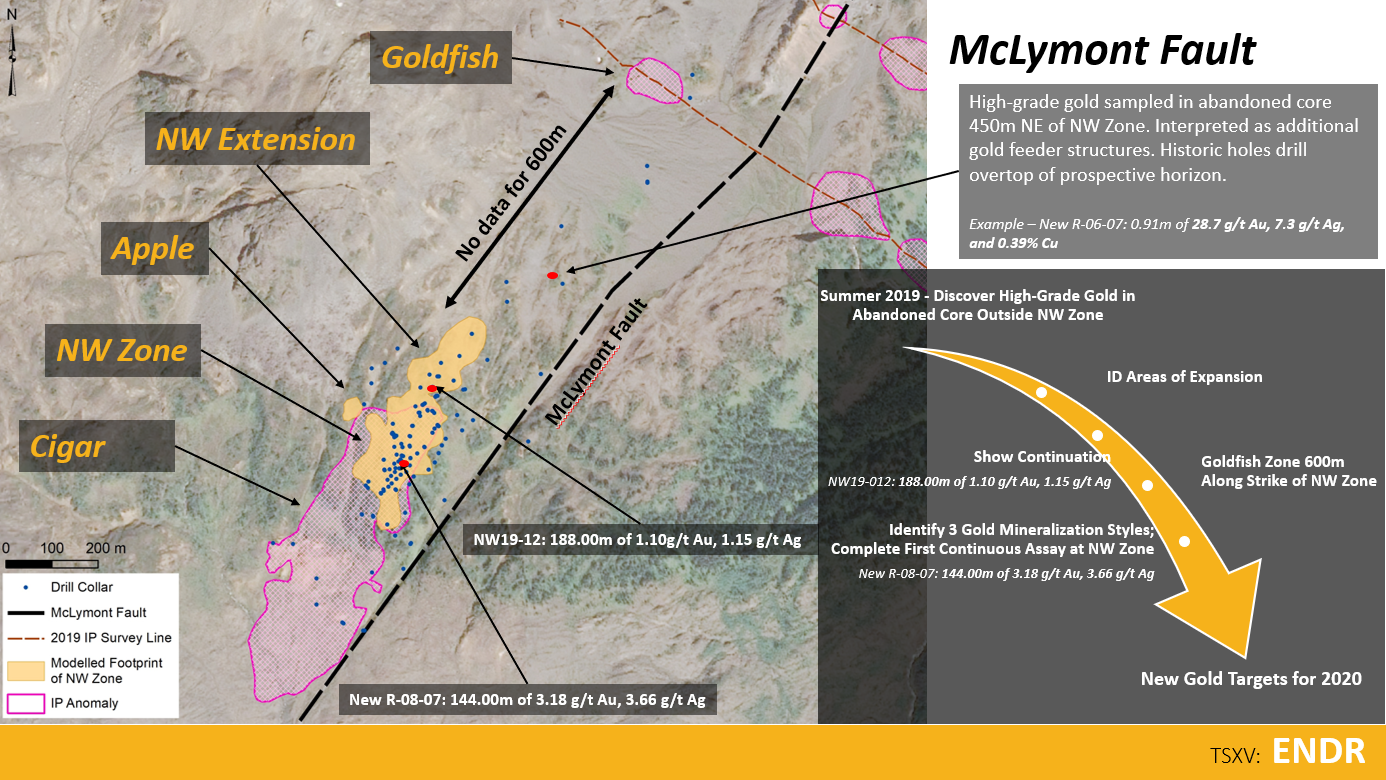
Figure 1: Plan view of McLymont Fault showing > 0.50 g/t Au interpolant with chargeability. Note historic drill collars are adjacent to prospective horizon, but do not intersect it.
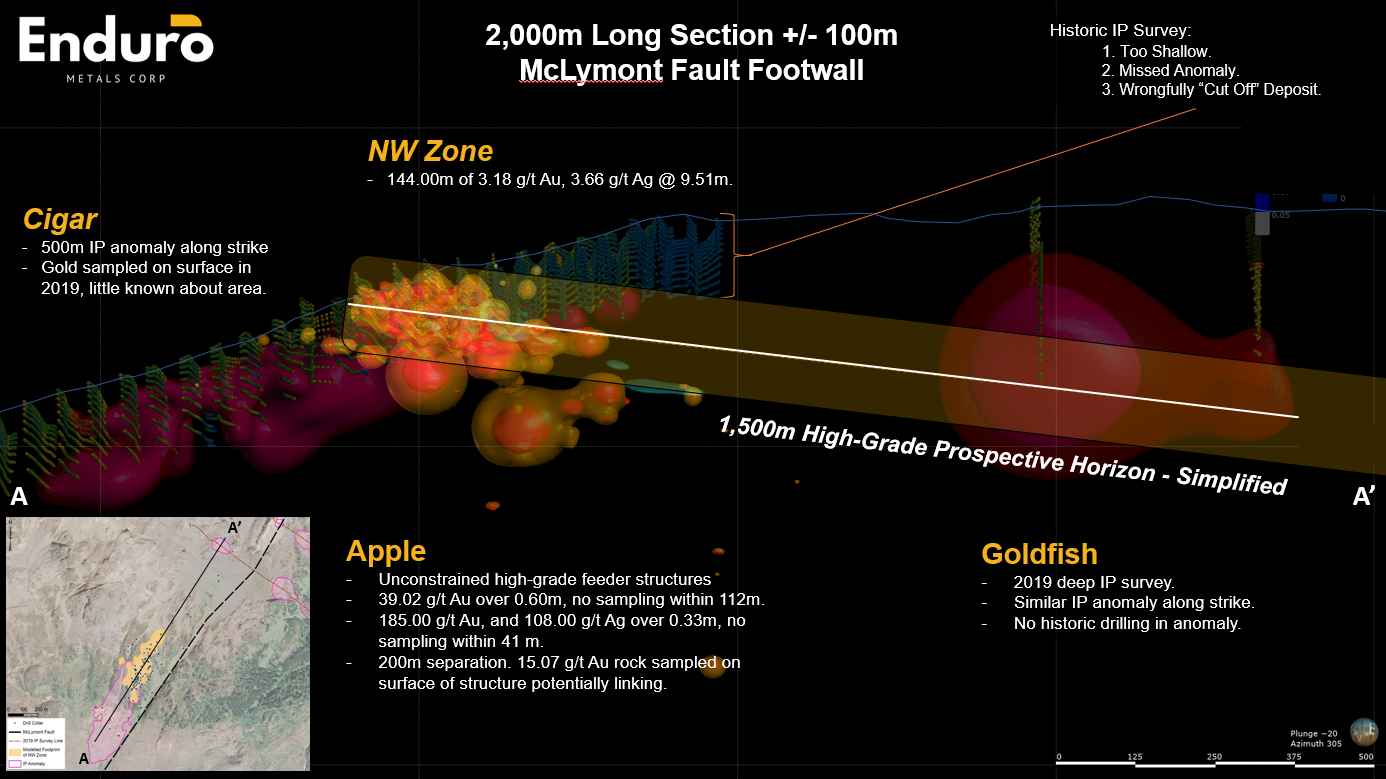
Figure 2: McLymont Fault 2,000m long section highlighting a prospective gold horizon connecting NW Zone and Goldfish. The Apple targets are hypothesized to be narrow, high-grade feeder structures to the NW Zone. Little is known about their potential depth extend, and little is known about Cigar at this time.
Goldfish
The newly discovered Goldfish Zone was identified in 2019 from a deep penetrating induced polarization (“IP”) geophysical survey by Walcott Geophysics directly along strike from the NW Zone. Goldfish shares the same chemical and physical characteristics as the NW Zone including high-grade gold in rocks on surface, similar high chargeability features, overlapping magnetic-low signature, and is hosted approximately 300m within the footwall of the McLymont Fault.
Additionally, Goldfish is on a double-fault junction between the McLymont Fault and a 3km north-south trending conjugate fault. This is the same structure which hosts the Company’s Ken Zone; an area identified by Newmont Mining Corporation in 1961 as being prospective for gold. Field work in 2020 will further delineate targets at Ken Zone and how it is possibly linked. Recent surface sampling identified high-grade gold, silver, and copper on surface including a chip sample containing 4.0m of 11.22 g/t Au, 4.12% Cu, and 43.54 g/t Ag.
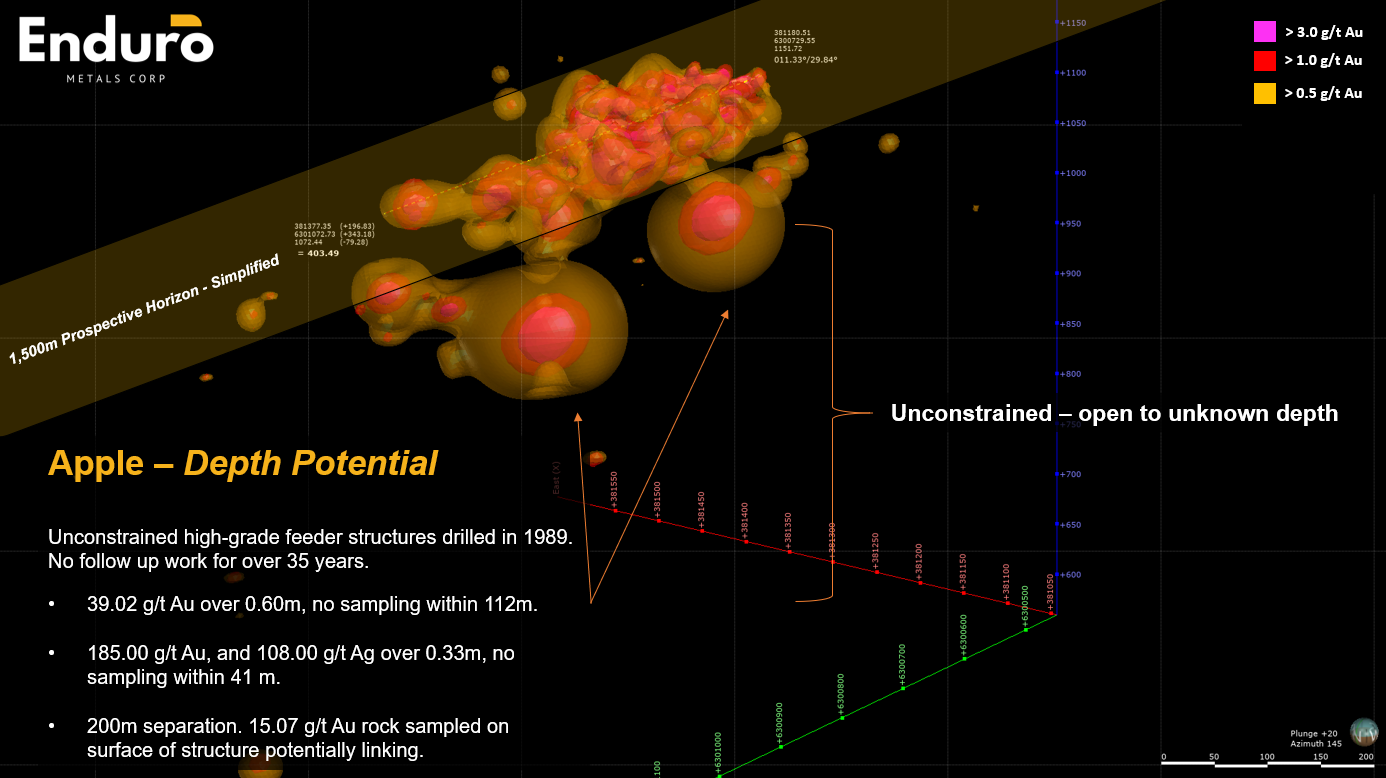
Figure 3: Southeast facing view of McLymont long section highlighting potential feeder structures known as the Apple targets. Note the interpolants are unconstrained due to a lack data in the area.
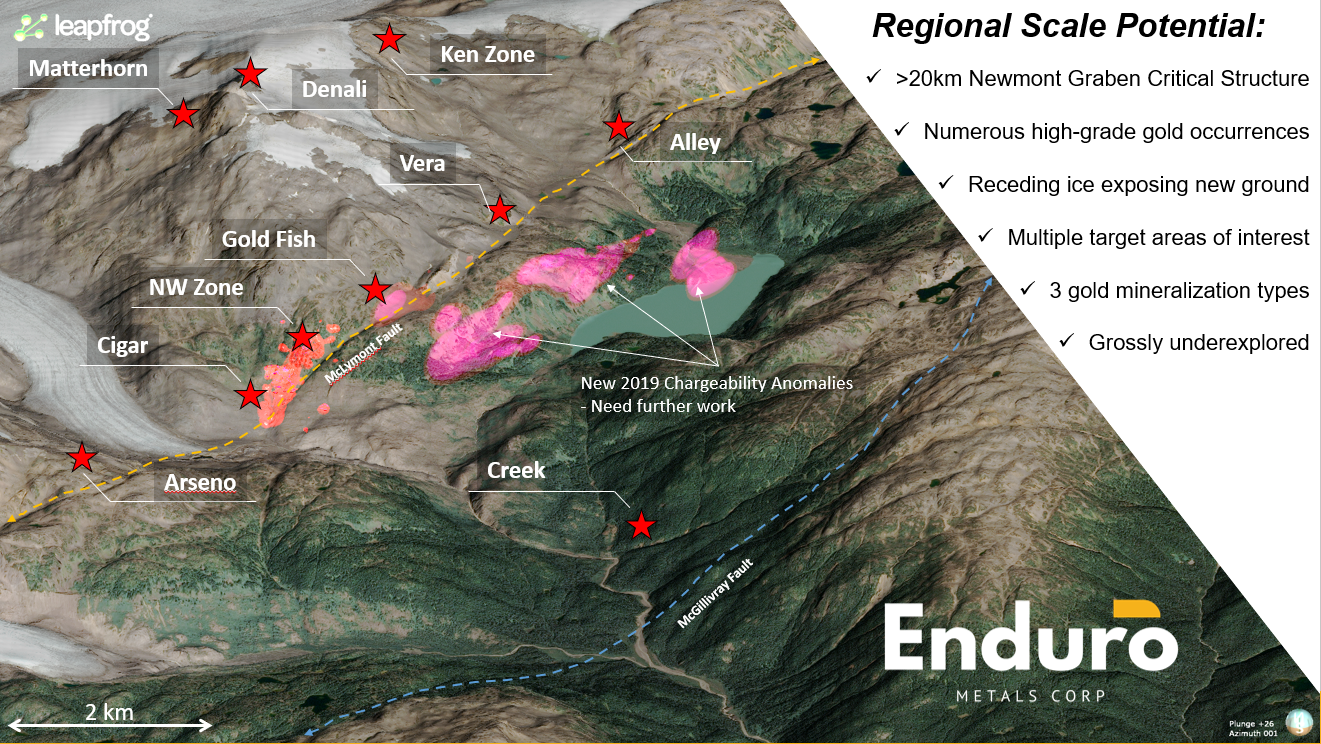
Figure 4: Aerial view of McLymont and the Newmont Lake Graben. Red stars are areas currently prospective for high-grade gold.
3 Mineralization Styles – All mineralization photos are from NW19-012

Figure 5: Massive pyrite-chalcopyrite skarn/replacement. Broad, high-grade gold (photo 44.03m of 4.03 g/t Au, 4.06 g/t Ag, and 0.29% Cu).

Figure 6: Deformed quartz-carbonate veining with chalcopyrite. Narrow, high to ultra-high-grade gold (photo 1.00m of 76.56 g/t Au, 11.54 g/t Ag, and 0.47% Cu). Examples of >350 g/t Au over 1.00m exist elsewhere in system.
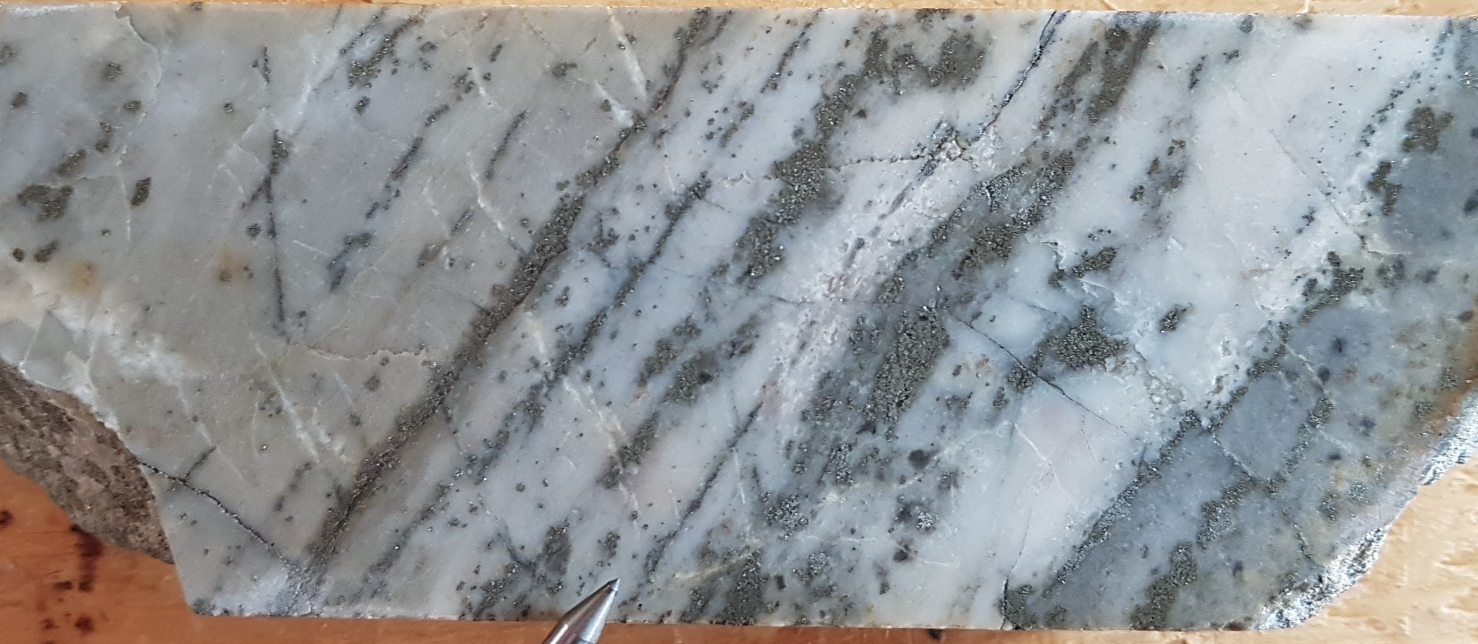
Figure 7: Disseminated and stringer pyrite/chalcopyrite. Broad, lower-grade gold intervals (photo 77.15m of 0.30 g/t Au, 0.30 g/t Ag). Testing of 3rd mineralization style has only reached 256m. Vectors indicate gold, silver, and copper grades are increasing with depth.
Cole Evans, President/CEO of Enduro commented “Gold deposits are cryptic, so it’s critical we know where the gold is sourcing, how it’s moving, and where it’s concentrating. Enduro has developed a strong criterion to find gold along the McLymont Fault, and there are several other areas which match our criteria thus far.
Gold mines have changed a lot in the 35 years since this area was first looked at. To put it into perspective, previous resource estimates were calculated with USD $475 per oz gold at an average grade of 5.12 g/t AuEQ. Today, the average grade worldwide of all open-pit gold mine is approximately 1.20 g/t AuEQ (Source: S&P Global Intelligence) and the gold spot price is USD $1,780 per oz. Our grades and intervals are encouraging, especially when stacked against global standards.
Drilling is still shallow within our prospective horizon, and there are many signs of significant high-grade feeder structures beneath and adjacent to the main skarn body. We have identified several new gold targets that will be tested in 2020 in addition to exploring more areas that match the Company’s criteria. Our Technical Study has turned everything we thought we knew on its head, and the McLymont Fault is wide open to find more gold. With the recently completed hydroelectric power plant only 16km away from where Enduro is drilling, this is a prime area to be looking for big gold deposits and we are just getting started.”
New Corporate Website and Presentation
We are also pleased to provide a link to the new company website and an in-depth Technical Presentation.
Please visit the website & presentation at: https://www.endurometals.com/presentation
Qualified Person
The technical information in this news release has been reviewed and approved by Mr. Maurizio Napoli, P. Geo., Director for Enduro Metals, a Qualified Person responsible for the scientific and technical information contained herein under National Instrument 43-101 standards.
About Enduro Metals
Enduro Metals is one of the leading exploration companies focused in the heart of British Columbia’s prolific Golden Triangle. The company’s highly qualified geological team has assembled a wealth of information generated by numerous companies each working small pieces of the district-scale property that Enduro Metals has assembled through staking and optioning. Building on prior results, the company’s geological team made several significant discoveries during its initial exploration program in 2019. A gold-rich copper porphyry outlined on the Burgundy Trend has striking similarities to large-scale deposits in the region, including the Red Chris deposit for which Newcrest last year paid US$807 million for a 70% interest. Chachi, a newly discovered area, generated high-grade samples of gold, silver, lead, zinc, nickel, and cobalt over a 9km x 4km area with associated geophysical responses. Diamond drilling in 2019 at the NW Zone demonstrated that the historic gold resource remains open laterally and to depth.
Work in 2020 will seek to further extend the known gold deposit and to investigate the large-scale discovery potential of multiple targets and deposit types.
On Behalf of the Board of Directors,
ENDURO METALS CORP.
“Cole Evans”
President/CEO
Email: info@endurometals.com
For further information please contact:
Investor Relations
Sean Kingsley – Director of Communications
Tel: +1 (604) 440-8474
Email: info@endurometals.com
Neither the TSX Venture Exchange nor its Regulation Services Provider accepts responsibility for the adequacy or accuracy of this release.
Cautionary Statement
Please note the visualizations are selected images highlighting strong visual mineralization and alteration from a variety of new showings and recent diamond drill core and are not necessarily representative of the entire area. The reader should also note that while relative spatial information is provided, mineralization is not necessary representative of space between any given location and it should not be assumed that lateral continuity exists. All deposit comparisons are for deposit model purposes and the mineralization hosted on these nearby or adjacent properties is not necessarily indicative of mineralization hosted on the Company’s property. The reader is encouraged to exercise caution, due their due diligence, and determine their own conclusions with the information provided.
QAQC/ Analytical Procedures
Rock samples from the Newmont Lake Project were sent to MSA LABS’ preparation facility in Terrace, B.C., where samples were prepared using method PRP-910. Samples were dried, crushed to 2mm, split 250g and pulverized to 85% passing 75 microns. Prepped samples were sent to MSA LABS’ analytical facility in Langley, B.C, where 50g pulps were analyzed for gold using method FAS-121 (fire assay-AAS finish). Gold assays greater than 100 g/t Au were automatically analyzed using FAS-425 (fire assay with a gravimetric finish). Rock samples were analyzed for 53 elements using method IMS-230, multi-element ICP-MS 4-acid digestion, ultra-trace level. Silver assay results greater than 100 g/t Ag and cobalt, copper, nickel, lead and zinc greater than 10,000ppm were automatically analyzed by ore grade method ICF-6.
Enduro conducts its own QA/QC program where three standard reference material pulps, two blank reference material samples are inserted for every 100 samples when analyzing rock samples.
Soil samples from the Newmont Lake Project were sent to MSA LABS’ preparation facility in Terrace, B.C., where samples were prepared using method PRP-757. Soil samples were dried and screened to 80 mesh, discard plus fraction. Prepped samples were sent to MSA LABS’ analytical facility in Langley, B.C, where they were analyzed for 51 elements using IMS-131 for samples with 20g or greater and IMS-130 for samples between 0.5g and 20g.
Enduro conducts its own QA/QC program where three standard reference material pulps, two blank reference material pulps are inserted for every 100 samples when analyzing soil samples.
Romios Gold 2007 QA/QC Procedures
As part of the sampling procedure, a QA/QC program was carried out to ensure accuracy in assay
results. This program is outlined below. One of four (HLHZ, FCM-2, 3C and BL-3) standards from an outside laboratory (CDN Labs6 of Delta, BC – standard certificates are included in Appendix E) were inserted into the sample stream. BL-3 is a blank. The number of QA/QC samples taken for the summer 2007 drill program total 49, or 10% of the 498 samples collected and submitted to the laboratory. This QA/QC program was completed in addition to the internal QA/QC program done by ALSChemex Labs. Any failures in the standards or blanks were evaluated in the field for any field related errors, and selected failed batches were re-assayed by ALS-CHEMEX Labs to determine the validity of the original assays. Appendix E contains a breakdown of the QA/QC program. Results are within acceptable limits.
Forward-Looking Statement
This news release may contain certain “forward looking statements”. Forward-looking statements involve known and unknown risks, uncertainties, assumptions and other factors that may cause the actual results, performance or achievements of the Company to be materially different from any future results, performance or achievements expressed or implied by the forward-looking statements. Any forward-looking statement speaks only as of the date of this news release and, except as may be required by applicable securities laws, the Company disclaims any intent or obligation to update any forward-looking statement, whether as a result of new information, future events or results or otherwise. Neither TSX Venture Exchange nor its Regulation Services Provider (as that term is defined in the policies of the TSX Venture Exchange) accepts responsibility for the adequacy or accuracy of this release.

